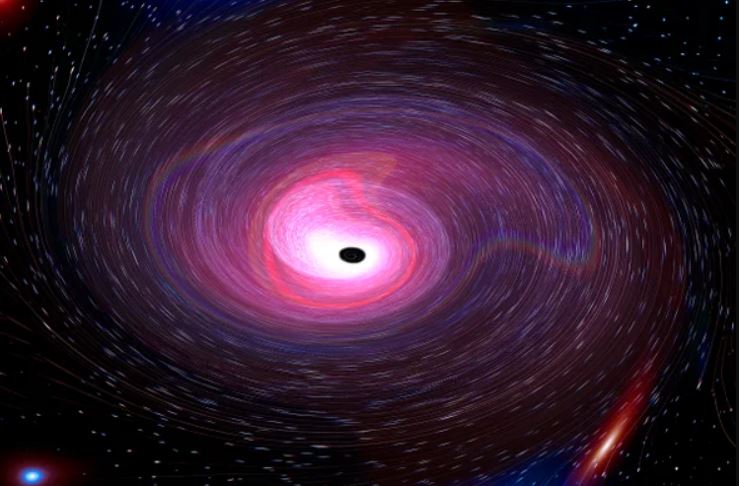Physicists Contemplate the Possibility that All Objects, Similar to Black Holes, Undergo Evaporation
Physicists’ Revised View: Not Just Black Holes, Everything Else Evaporates too
The evaporation of black holes, where particles gradually disappear, has long been a known phenomenon in physics. However, a recent study suggests that this process may extend beyond black holes and apply to everything in the universe. The research explores the effects of physics that were previously believed to occur only in the vicinity of black holes. In these extreme environments, the largest and smallest entities in the universe interact. Describing events that occur on such contrasting scales requires a combination of Einstein’s theory of relativity, which governs macroscopic objects, and quantum mechanics, which applies to the microscopic realm. This unique combination of principles leads to extraordinary effects. If the new calculations are accurate, these effects may be more common than previously assumed, even in the absence of black holes.

The exploration of what occurs when the minuscule encounters the immense began in the 1970s. British physicist Stephen Hawking pondered the fate of particles experiencing immense gravitational forces near the edge of a black hole, known as the event horizon. Hawking focused on pairs of particles, consisting of a particle and its antiparticle, that spontaneously appear at the event horizon. These pairs emerge from the seemingly empty vacuum of space, constantly materializing and vanishing due to the principles of quantum mechanics. When a particle meets its antiparticle, they annihilate each other in an instant, with no noticeable impact on the larger universe.
Hawking demonstrated that if one member of the particle-antiparticle pair appeared inside the event horizon, it would fall into the black hole, while its partner outside the event horizon would be forcefully expelled. To uphold the total energy balance of the black hole and adhere to the principles of physics, the infalling particle must carry negative energy and negative mass, while the expelled particle must possess positive energy. Consequently, black holes emit a type of energy known as Hawking radiation, leading to their gradual depletion and eventual evaporation over time.
Around six years ago, astrophysicist Heino Falcke and his team at Radboud University in the Netherlands began to delve deeper into the physics underlying these processes, questioning whether the event horizon was a necessary component. They sought expert opinions on this matter, which yielded varying responses. To explore the topic from a different perspective, Falcke enlisted the assistance of quantum physicist Michael Wondrak and mathematician Walter van Suijlekom, both from Radboud University. They employed equations related to the Schwinger effect, a phenomenon describing how charged particles and antiparticles separate when emerging from the vacuum in the presence of a powerful electromagnetic field. This process can be seen as analogous to particle pairs experiencing strong gravitational forces near a black hole’s event horizon.
The team’s mathematical analysis revealed that any object with mass, not limited to supermassive black holes, impacts the particle-antiparticle pairs that arise from the vacuum of space. These particles can be visualized as having a cloud of probability surrounding their potential spatial locations. In the absence of external forces, such as electromagnetic or gravitational influences, the clouds of both the particle and antiparticle overlap, resulting in annihilation. However, if gravity affects one cloud more than the other, they will be shifted, causing non-overlapping and non-annihilating states. Instead, they will emit radiation, akin to particles expelled from a black hole’s event horizon.
The team’s calculations, published in Physical Review Letters on June 2, indicate that any object with gravity, essentially encompassing all objects in the universe, will emit Hawking-like radiation and eventually evaporate. The process, however, is estimated to take trillions upon trillions of years, making it unlikely to occur within our lifetime. Nevertheless
the findings raise intriguing possibilities for the future of long-lived celestial remnants like white dwarfs and neutron stars. These massive objects may have their lifespans shortened if the phenomenon holds true.
The research has received positive feedback, with experts acknowledging its potential implications. Tyler McMaken, a theoretical astrophysics Ph.D. student at the University of Colorado Boulder, finds the study promising, highlighting the revelation that gravitational forces alone can cause particles to be torn apart in the vacuum. McMaken and his colleagues are considering conducting similar calculations, making this comprehensive examination valuable in exploring the outcomes of such situations.
However, not all researchers share the same viewpoint. Theoretical physicist Sabine Hossenfelder from the Munich Center for Mathematical Philosophy in Germany remains skeptical and suggests that previous calculations on particle behavior near massive objects may not be entirely flawed. Hossenfelder anticipates that a more meticulous analysis will reveal that particle-antiparticle pairs do not radiate from non-black hole objects with significant mass.
As scientific exploration continues and more studies are conducted, a clearer understanding of the intricate interactions between gravity, particles, and evaporation processes will emerge. The quest to uncover the fundamental laws governing the universe’s behavior at both the macroscopic and microscopic scales remains a captivating and ongoing pursuit in the field of physics.
At present, the sensitivity of existing technology is insufficient to detect and provide conclusive evidence for the evaporative effect proposed by the study. The assertion made in the research cannot be definitively proven or disproven using current technological capabilities. To support their claims, Falcke and his team propose that experiments should concentrate on observing the Schwinger effect, which is also a theoretical phenomenon. By investigating the Schwinger effect, there is a possibility that their own assertions could be strengthened. Such experimental endeavors hold the potential to shed further light on the topic and offer insights into the validity of the proposed evaporation process.
Do not forget to share your opinion with us to provide you with the best posts !



0 Comments